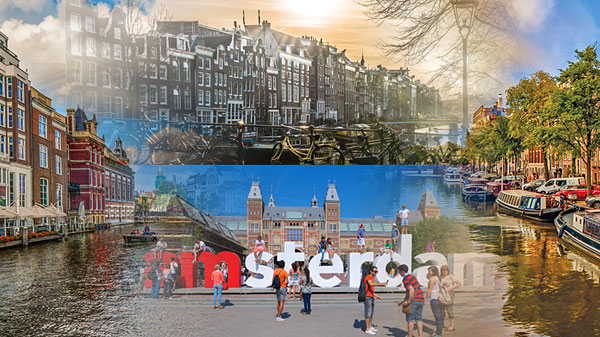When it comes to the best places to live in the world, there are only five that appeal more than the Netherlands, particularly its capital Amsterdam. As that particular accolade bears the imprimatur of the United Nations (as detailed in the body’s 2018 World Happiness Report), that’s pretty much as official as you are going to get.

Anyone minded to uncover why the Netherlands has developed such never-leave-ability should start their investigation in Amsterdam, the national capital. Here, among the ‘Exhibit A’s’, are historic monuments, trendy hipster cafes, quaint canals, a world-class red light district and more museums than you explore in any one trip.
The city, itself, dates back to the late 13th century, when a dam-cum-bridge was built across the River Amstel to protect local inhabitants from the ever-present danger of flooding. The nearby settlement eventually became known as Amsterdam.

Although a relative youngster compared to such venerable Dutch cities as Rotterdam and Utrecht, Amsterdam soon flourished, quickly emerging as one of the region’s key commercial ports. Later, during the 17th century Dutch Golden Age, the city became an economic powerhouse, boosted by such innovations as the establishment of the world’s first stock market.
Before long, it was seen as the world’s wealthiest city. Its affluence and influence only grew as its trading network extended across North America, Africa and Asia. Buoyed by the success of the semi-state-owned Dutch East India Company – now considered the world’s first transnational conglomerate – it then went on to annex both Sri Lanka and Indonesia.

Today, although such glories are long gone, the city remains as one with its waterways, once the commercial arteries that ferried the finest goods from across the world into its very heart. Its 165 canals and 1,281 bridges, in fact, all constitute parts of one of UNESCO’s most singular World Heritage Sites.
Without a doubt, though, many of Amsterdam’s most popular attractions can be found very much on dry land and, more particularly, within the Museumplein (Museum Quarter), home to innumerable historical repositories of the very finest examples of Dutch historical and cultural artefacts.

A good place to start would be the Big Three – the Van Gogh Museum, the Rijksmuseum and the Stedelijk. Perhaps the biggest of these is the Rijksmuseum. Originally constructed 100km away in 1800 in The Hague, it settled into its current location in 1885. Within the imposing exterior architecture is a veritable treasure trove of works from many of the Dutch Old Masters, the majority of them created during the region’s Golden Age.
A total of 8,000 pieces are on display, including such celebrated pieces as The Night Watch (Rembrandt), The Milkmaid (Vermeer) and The Meagre Company (Hals). Discerning visitors tend to arrive early and head straight to the second-floor Gallery of Honour where most of these masterworks are to be found.

Almost directly adjacent to the Rijksmuseum is the Van Gogh Museum, an institution solely dedicated to the life and works of this magnificent Dutch Post-Impressionist painter. Opened in 1973, it boasts the world’s largest collection of the uni-lobed artist’s paintings and correspondence. For the most fulfilling experience, opt for the informative audio guide facility as you peruse your way across Van the Man’s finest works.
For those intent on uncovering more contemporary cultural icons, look no further than the nearby Stedelijk. Boasting more than 90,000 of the 20th and 21st centuries’ artiest artefacts, virtually every significant cultural movement from modern times is represented here, including Pop Art, De Stijl and Neo-Impressionism, often by their very finest manifestations.

Further away, tucked in an unassuming canal-side construction is Anne Frank House, one of the city’s most chilling repositories of remembrance, It was here that Anne Frank, a 13-year-old Jewish girl, hid from the Nazi pogroms that blighted the city at the height of WWII before being caught and transported to the German concentration camps claimed her life. Her now-famous diary, which recorded her time in hiding, did survive and remains a powerful condemnation of the horrors of the time.
The original hidden annex where Anne and six others took sanctuary for two long years is now open to visitors. For many, it remains a place of pilgrimage and sombre reflection. Afterwards, should you have the appetite, drop by Pancakes Amsterdam next door and sample the Netherlands’ unique take on this classic breakfast offering. Or, for a spot of probably desperately-needed cheer, meander down the canal-hugging Prinsengracht for a spot of retail therapy.

If your quota of museum meanderings is yet to be wholly filled, there are still plenty more to choose from. Amsterdam, after all, boasts more than 75 different museums, dedicated to everything from houseboats to household pets. After that, you probably deserve a bit of a sit down and the opportunity to explore those intriguing aromas wafting from many of the city’s curiously full cafes. Enjoy.
Text: Tenzing Thondup
Images: AFP



